German King Tiger Tank

The King Tiger tank was one of the most feared tanks
of World War 2
| The
German King Tiger Tank was introduced in early 1944 and
was the most powerful tank during world war 2. With its powerful
88mm gun and an almost impenetrable front armor, it was one
of the most feared tanks of world war 2. Up to the end of the
war, the allies did not have any effective means to counter
the threat. |
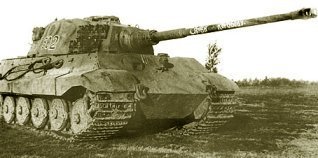
|
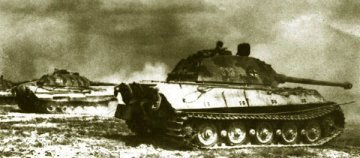
|
| Henschel King
Tiger Tank #502. "Glory to Korobov" is inscribed on the barrel.
|
Porsche King
Tiger Tanks during firing trials.
|
|
Development History
|
 |
|
German heavy tank development began as
early as 1937 with the German Armaments Ministry issuing a specification
for a new heavy tank to Daimler-Benz, Henschel, MAN and Porsche.
The project however was ignored as the Panzer III and IV had
so far proved effective tanks and served well in combat.
It was not until spring 1941 that the project was revived after
Hitler was impressed with heavy allied tanks, such as the French
Char B1 and British Matilda 1 during the campaign in the west.
At a meeting with Hitler on 26th May, 1941, the planning for
the development of a new heavy tank begun. During that meeting,
Hitler ordered for the creation of heavy Panzers which were
to have an increased effectiveness to penetrate enemy tanks;
possess heavier armor than was previously achieved; and attain
a maximum speed of at least 40km/h. These key decisions led
to the development of a new heavy tank, the Tiger 1 tank and
ultimately the King Tiger. However, no clearly defined objectives
or action plans were laid out for the succession of the Tiger
1 tank until January 1943 when the order was given for a new
design which was to replace the existing Tiger 1.
Although the designation implies that the Tiger II is a succession
of the Tiger 1, it is in effect a completely different tank.
The first design consideration for the new tank was the selection
of a more effective main gun. As with the Tiger tank, it was
to mount an 88mm anti tank gun but the main gun on the Tiger
II was far more powerful than that on the Tiger 1. For the development
of the chassis, two firms were contracted to come up with the
designs namely Henschel and Sohn of Kassel and Porsche of Stuttgart.
Both firms Henschel and Porsche were responsible for only the
chassis and automotive designs. Turret design was awarded to
another firm Krupp of Essen.
The main gun specification of the King Tiger was to be a variation
of the 88mm anti-aircraft gun. Although the 88mm was initially
designed for an anti aircraft role, it proved to be an excellent
tank killer. Originally, the intention was to mount an 88mm
Flak 41 into a turret for the Porsche VK4501 (P) chassis. The
turret had been originally designed by Krupp to hold the 56
caliber 88mm KwK 36 gun of the Tiger 1. After much experimentation
and debate, it was decided in early 1943 that it was not possible
to mount the 88mm Flak 41. Krupp had then been contracted to
design a new turret that could mount their own version of a
71 caliber 88mm Kwk 43 gun that could fit in both the chassis
for Henschel and Porsche.
The 88mm gun with the designation KwK 36 and KwK 43 indicated
the model number year 36 and 43. The Tiger II with the model
43 has a length of 71 calibers (71 times 88mm) as compared with
56 calibers of the Tiger 1 with model 36. The length of the
barrel itself is over 20 feet long while the rounds weighed
almost 20kgs. It is in effect a much more powerful gun than
the Tiger 1.
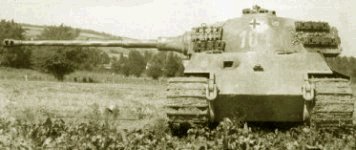
|
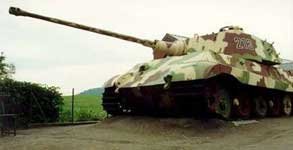
|
| King
Tiger with the Henschel (production) turret. Note
the length of the 88mm. |
One
of the few surviving tanks on display at LaGleize
museum.
|
The King Tigerís 88mm main gun has a muzzle velocity of 1000m
per second when firing armor piercing rounds. It was highly
accurate and able to penetrate 150mm of armor at distances exceeding
2200m. Since the flight time of an armor piercing round at a
range of 2200m is about 2.2 seconds or less, accuracy and correction
of fire against moving targets is more important than with older
anti tank guns. This made this heavy predator ideally suited
to open terrain where it could engage enemy tanks at long range
before the opponentís weapons were even in range.
For the chassis, much has been learnt from the sloped armor
design of the Russian T-34. As with the Panther, the King Tiger
was to have sloped and interlocked front and side armor. The
front armor was 150mm thick and the side was 80mm thick. Both
firms Henschel and Porsche submitted their own designs.
Porsche designed the VK4502 (P) chassis which was built on the
previous VK4501 (P) design of the Tiger 1. The codename VK was
for Volkettenfahrzeuge or "fully tracked experimental vehicle",
45 means a 45 ton class and 01 represents the first model. The
VK4502 (P) chassis had a similar outlook with the Tiger 1, sharing
many similarities such as the suspension and automotive parts.
Two designs were submitted, the first one having its turret
mounted centrally and the second had the turret mounted towards
the rear with the engine in front. However, it used copper for
the electric transmission which Germany was in shortage of.
This design was rejected and did not enter production.

|
| Henschel
production turret. |
Henschel designed the VK4503 (H) chassis which was very similar
in appearance to the Panther. The front armor was 150mm thick
and sloped at an angle of 50 degrees. The side was 80mm thick
sloped at 25 degrees. As with all German tanks at that time,
it had a ball mounted MG34 fitted on the right front side of
the hull. The suspension consisted of torsion bars with nine
sets of overlapping steel rimmed wheels on each side. The tracks
were 2 feet 8 1/2 inches wide, weighing 2.5 tons. Henschelís
design was accepted and destined to enter mass production.
Krupp had designed the turrets to fit both the Porsche and Henschel
chassis. The initial design called P-2 Turm (or commonly known
as Porsche turret) mounted a single piece (monobloc) barrel
of the 88mm and had a curved mantlet in the front. The front
armor was 100 mm thick, the sides were 88mm thick sloped at
60 degrees and the top armor was 40mm thick. It had space to
carry 16 rounds of ammunition in the turret. However, the curved
mantlet in the front acted as a shot trap by deflecting incoming
shots downwards towards the roof of the hull. A new design was
ordered to fix this but as an interim measure, it was decided
to go ahead with the production of 50 units with this turret.
This was commonly referred to as Porsche turret. The new design
called Serien Turm, or commonly known as Henschel or Production
turret was to retain the many features of the Porsche turret
and was to be adopted for mass production. Henschel turret had
the front curved mantlet replaced with one 180mm thick armor
plate sloped at 81 degrees. The sides were altered to slope
at 69 degrees and it could carry an additional 6 six rounds
or 22 rounds of ammunition in the turret. The full combat weight
was 68,500kg when fitted with the Porsche turret and 69,800kg
with the Henschel turret.
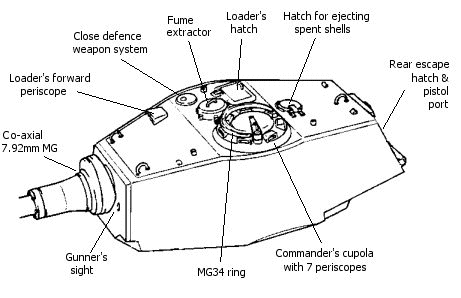
|
Although the two turrets were
different in appearance, it had the same layout. The
large overhang at the rear acted as counter balance
for the heavy gun. This additional space was used to
store ammunition making the loaderís job easier. It
had three hatches, the commanderís hatch on the left,
the loaderís hatch on the right and as escape hatch
in the rear. The turret housed three of the five crews.
The commanderís position was on the center left, the
gunner below and in front of him and the loader on the
right.
For the engine, it used a Maybach |
HL 230 P30 engine which was the same as
was fitted to the Panther. It produced 700hp of output which
was inadequate for a tank this size, which was 11 tons heavier
than the Panther. This made the King Tiger miserably underpowered
and susceptible to surprise flank attacks. Although a maximum
road speed of 41.5km/h has been achieved during trials, it could
sustain only 35 to 38 km/h on the road and 17 km/h cross country.
The transmission was an 8 speed Maybach OLVAR EG 40 12 16 B
gearbox (8 forward and 4 reverse). Besides the electric starter
motor, the engine is also equipped with a crank starter to conserve
battery power on cold days. Fuel consumption was enormous with
the Mayback V12 engine needing 500 liters per 100km. This was
a problem at that time as Germany was in constant shortage of
fuel. It carried 860 liters of fuel giving it a maximum range
of about 110km on the road and 80km cross country. As with the
Tiger 1, the massive size of the tank could not fit into the
standard rail compartment. To overcome this, two sets of tracks
were needed, one narrower 66cm transportation tracks and a wider
80cm combat tracks.
Combat Service
|
 |
Officially designated Panzerkampfwagen
VI Sd.Kfz 182, the King Tiger was placed into service early
1944. It served in the western and eastern front notably in
the battle of Normandy, operation "Market Garden" in Holland,
and the offensive in Ardennes. It also served in various other
operations in Poland, Hungary, Minsk and a small number also
defended Berlin in April and May 1945. With its great firepower
and thick armor, it proved to be more than an opponent for any
tank the allied forces could field. However, the size and weight
of the King Tiger had its share of problems. It suffered mechanically
with many breakdowns and had poor maneuverability. Many roads
and especially bridges were not suitable for a tank this size
and the fuel requirements was enormous. Many were abandoned
due to lack of fuel rather then being destroyed during the offensive
in the Ardennes. Production also suffered with the bombing of
the Henschel factory and there simply werenít enough of these
around. The King Tiger was a case of too late and too few in
number to make a difference in the outcome of the war.
However, the great firepower and armor of the King Tiger created
the impression of a powerful armored force with almost invulnerable
tanks. Able to destroy enemy tanks at extreme ranges and impervious
to those same tanks made the King Tiger more than a match for
any allied tank. Indeed for the allied forces, the sight of
a King Tiger on the battlefield was terrifying and did great
physical and morale damage to the enemy. This fame and almost
mystical fascination helped it earn its reputation as the most
feared weapon of world war 2. For the German forces, it was
the hallmark of German armored might and restored morale even
in the last days of the war. Due to the havoc it wreaked during
the Ardennes offensive, the allies advancing into Berlin would
fear the King Tiger up to the very last day of the war.
|
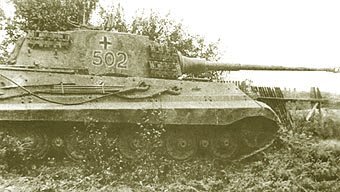
|
|
Tank
#502 abandoned at Ogledow, eastern front.
|
Specifications
|
 |
Panzerkampfwagen
VI Ausf. B (Sdkfz 182)
|
|
Other
designation: King Tiger, Tiger II, Royal Tiger, Konigstiger
|
| Type:
Heavy tank |
|
Manufacturer:
Henschel, Krupp
|
Chassis
Nos: VK4503 (H)
|
Production:
485 units including various variants from December
1943 to March 1945
|
| Crew:
|
5
(three in turret) |
| Weight
(tons): |
68.5
(Porsche turret)
69.8 (Henschel turret) |
| Height
(meters): |
3.09
|
| Length
(meters): |
7.62
(excluding gun barrel)
10.28 (including gun barrel) |
| Width
(meters): |
3.66
(without skirting)
3.76 (with skirting) |
| Engine:
|
V12
Maybach HL 230 P30 (700hp) |
| Gearbox:
|
Maybach
OLVAR EG 40 12 16 B (8 forward and 4 reverse)
|
| Speed
(km/h): |
35 -
38 (road)
17 (cross country) |
| Range
(km): |
110
(road)
80 (cross country) |
| Radio:
|
FuG
5 |
| Armament:
|
88mm
KwK 43 (71 calibers)
1 hull MG 7.92mm
1 coaxial MG 7.92mm
1 commander's hatch MG 7.92mm |
| Ammunition:
|
88mm
- 80 rounds (Porsche turret), 86 rounds (Henschel
turret)
7.92mm - 5850 rounds |
| Sight:
|
TZF
9b later changed to TZF 9d |
| Armor
(mm/angle) |
Front |
Side |
Rear |
Top/Bottom |
| Porsche
turret |
100/curved |
80/30 |
80/30 |
40/77 40/90 |
| Henschel
turret |
180/9 |
80/21 |
80/21 |
40/78 40/90 |
| Superstructure |
150/50 |
80/25 |
N/A |
40/90 40/90 |
| Hull |
100/50 |
80/0 |
80/0 |
40 - 25/90 |
This particular tank #213 on display outside the La Gleize Museum
was one of the six left behind by Kampfgruppe Peiper during
the Ardennes offensive. It was part of the 501st Abteilung,
commanded by Dollinger and was abandoned in front of the town
hall. Most of those left behind in the Ardennes had either ran
out of fuel or broken down rather than destroyed. In La Gleize
one of the captured tanks was used as target practice by US
troops once the village had been retaken. They fired bazooka
after bazooka round at it - none penetrated!! This one was restored
some years ago, the main gun being damaged. It was repainted,
but the original tank number, '213' was kept. It was moved to
its present site in 1951.
|
Photo Gallery
|
 |
King
Tiger Tank Photo Gallery
Contact Webmaster
Mike Kaspar
|
|

